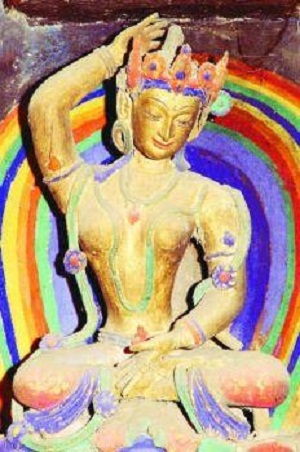Lhalung Monastery is the earliest monasteries founded in Spiti, Himachal Pradesh, India. Other names of this monastery are Lhalung Monastery, Lhalun Monastery, Golden temple, Sarkhang. Lhalun means Land of Gods. Lhalun is derived from two words Iha and Lung. Iha means Deities, Devatas and Lung means Land, area. It is largest in Lingti Valley.
What to see in Lhalung Monastery:
Main Chapel is richly decorated with the images of different shrines. It is a temple complex consists of 9 shrines. Lhalung means Land of Gods. It is believed that, Lhalung is the head of all the deities of this valley. Colour of Mountain changes from time to time. This colour depends on the moods of the gods. For example Yellow colour symbolises for Joy and Red colour is the symbol for Anger.
It is believed that this temple was built by Gods in one night. This was constructed by the gods after Lotsava Rinchen Zangpo Planted a willow tree in this place. One interesting thing is that this willow tree can be seen even now. Lhalung Monastery was found by the great Rinchen Zangpo. During late 10th century he ruled Western Himalayan Kingdom’s of Kinnaur, Spiti, Guge, and Zanskar.
Gold leaf deities kept in its shrine so this temple is also known as Golden Temple. Walls of this monastery are so beautiful. Images of 50 deities can be seen on the walls of this monastery. Passage walls of this temple are beautifully decorated with different paintings. Outside the Gompa Buddha shrine is so attractive which was in white colour. This image of Buddha is displayed in four cardinal directions. This statue was placed here at the time of construction of this monastery itself.
What to see around Lhalung Monastery:
Lahaul Valley: It is located 2745meters above the sea level. It is the subdivision of Lahaul Spiti district but this place is entirely different from Spiti. This place is more developed when compared with spiti. Lahaul Valley is most beautiful with greenery. Gateway to reach Lahaul and Keylong is Rohatang Pass.
Kaza: This is the starting point for trekking from Spiti. Other attractions of this place are Hikkim monastery and Sa-kya-Pa sect Monastery. Most of the government offices located in this place.
Getting to Lhalung Monastery: In the bus route Manali is 115kms away from this monastery. Other option to come to this place is from Shimla via Kinnaur to Kaza. This route remains open only between May to October. Nearest railway station is Jogindernagar. Chandigarh and Shimla are nearest broad gauge railway stations. From Chandigarh and Shimla buses and taxis are available to reach Spiti. Through air route, Spiti can be reached either from Shimal or from Manali. Bhuntar airport near Manali is operating some private and Indian airlines to other places. Flights from Kullu, Chandigarh, and New Delhi come to Shimla airport on regular basis.
Getting around Lhalung Monastery: Best way to explore this monastery is on foot.
Best time to visit Lhalung Monastery: As this place is valley region it is essential to known the best time before visiting this place. Best time to visit this place is between March to October.
Where to stay in Lhalung Monastery: No accommodations available in Lhalung Monastery. Private and government guest houses are available to stay in Spiti, Poh, Samd, Losar, Tabo and Kaza. In nearby villages plenty of home stays are available with best budget accommodations. Home stays are available in Mikkim, Dhankar, Lhalung, Demul, komic, Langza.
Where to eat in Lhalung Monastery: Eateries are not available in Lhalung Monastery. In Spiti some restaurants can be seen. Specializations of these restaurants are local dishes and Tibetan food.

